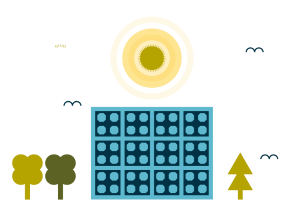Dutch government shifts policy on solar panels on farmland
Published on 7th August 2023
To minimise the impact on nature, solar parks on agricultural land will be restricted.

In his letter (Kamerbrief) to parliament of 6 July 2023, the Dutch minister for economic affairs and climate set a key shift in policy regarding solar parks in the Netherlands. It should be noted however that on 12 July 2023, the Dutch government collapsed and a new government will take over after elections. The outcome of the elections, taking place on 22 November 2023, will determine whether the Dutch government will maintain its current course.
The growth of solar power in the Netherlands hit an all-time high in 2022 with around 4.2 GW of installed power. The National Plan Energysystem (Nationaal Plan Energiesysteem) (NPE) predicts that in 2050, the output of solar panels in the Netherlands will hit 173 GW. The NPE is the holistic plan developed by the Dutch government setting out what the future energy system of the Netherlands should look like.
Solar panels on farmland are one of the contributors to the overall output, but it seems that this may be put to a halt by the Dutch government, since it has moved granting permits for solar panels on farmland to the bottom of its list.
Key items included in the letter
The letter set out the importance of solar power within the Dutch energy strategy. It outlines the course that the Dutch government will be taking with regard to solar power on the following six topics:
- Spatial aspects (ruimtelijke aspecten);
- Responsible and qualitative development of solar panels;
- Net capacity and system integration;
- Equitable distribution of benefits or solar panels;
- Increasing production capacity of solar panels in Netherlands and Europe; and
- Safety of solar panels and their installation.
This Insight considers the first topic, and in particular, the policy change with regard to solar panels on farmland.
The solar ladder
The National Environmental Vision 2020 (Nationale Omgevingsvisie) introduced the a priority list of placement of solar panels (Voorkeursvolgorde Zon), known as the solar ladder.
The solar ladder of 2020 set an order of preference for the roll out of new solar panels in an attempt to facilitate the energy transition, while minimising the impact on the functioning of society and natural eco-systems. It decided that:
- first priority should be given to the implementation of solar panels on rooftops;
- second priority should be given to the implementation of solar panels on land in urban areas;
- thirdly, implementation of solar panels on land in rural areas; and
- finally, the implementation of solar panels on agricultural and natural areas should be limited as much as possible.
Research has shown that all Dutch provinces and many municipalities have included some form of a solar ladder in their policies. However, the lack of a clear universal definition of this policy, especially with regard to the multifunctional use of land, has been raised as a key issue. Changes to the solar ladder
The government intends to strengthen the focus and the enforcement effects of the solar ladder, by giving increased direction to provinces and municipalities on how it should be implemented.
This new government direction is expected to come in the form of new instructional rules (instructieregels) on the implementation of the preferential order of solar infrastructure roll out. It will place the priority on stimulating energy infrastructure on rooftops, and on encouraging multifunctional implementation on urban and rural land, where it can create social added value, or contribute to landscape, ecology or nature.
The new policy with respect to the solar energy infrastructure on farmland will be "no, unless". A limited set of exceptions will be introduced, whereby the conditions of temporariness and multifunctional use will in each case become important.
In the next five months more details will be published on the exceptions. However, it has been made clear that any persons intending to make use of these exceptions will first have to take all reasonable steps to implement projects under the prior three steps.
This new "no, unless" policy is intended to be rolled out by 1 July 2024, along with the obligations and subsidies for the implementation of solar panels over car parks, passed by the Dutch parliament in March of this year. Exactly what form this guidance will take is currently being discussed and should be made public in September of this year.
This shift in policy to minimise the impact on nature will also have consequences for conditions for acquiring a permit to develop new solar projects. The government, the Association of Dutch Municipalities, and the Interprovinciaal Overleg (which represents the interests of the twelve provinces) are currently considering implementing requirements around nature inclusiveness in local permits for solar projects. They are also undertaking a broader investigation into potential spatial and financial instruments which can be set up to encourage a broader assurance with regard to nature inclusiveness.
Criticism
The decision has faced backlash from those in the renewable energy sector. Wijnand van Hooff, chairman of Holland Solar, has labelled the new policy unnecessary and incomprehensible, as well as stating that solar parks on agricultural land are going to be needed to meet the Dutch and EU energy targets.
The ministry of the interior and kingdom relations (BZK) has conducted research making rough estimates that there is a potential 145GW of energy to be extracted from rooftops, and a further 9.5 GW to be extracted from applicable urban and rural land (other than farmland): more is to be gained using space other than farmland for solar panels. It remains to be seen, and will depend on technical developments, whether those other areas are sufficient to generate sufficient renewable energy.
Osborne Clarke comment
This change of policy will have adverse consequences for what seemed to be a lucrative business for owners of farmland. It may also require investors to change their focus to the first three options in the solar ladder if they wish to continue to expand their solar park portfolios.
Apart from the developments on the placement of solar panels, the letter shows that there are many other developments going on with regard to their use. This demonstrates that solar power remains a crucial part of the energy transition in the Netherlands. Although part of the policies could be adjusted following the new upcoming elections, solar power will no doubt remain a very important pillar for the Dutch energy system.
Ruben Stokroos, student trainee at Osborne Clarke, contributed to this Insight.



